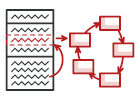
State em Python
O State é um padrão de projeto comportamental que permite que um objeto altere o comportamento quando seu estado interno for alterado.
O padrão extrai comportamentos relacionados ao estado em classes separadas de estado e força o objeto original a delegar o trabalho para uma instância dessas classes, em vez de agir por conta própria.
Complexidade:
Popularidade:
Exemplos de uso: O padrão State é comumente usado em Python para converter enormes máquinas de estado baseadas no switch para dentro dos objetos.
Identificação: O padrão State pode ser reconhecido por métodos que alteram seu comportamento, dependendo do estado dos objetos, controlados externamente.
Exemplo conceitual
Este exemplo ilustra a estrutura do padrão de projeto State. Ele se concentra em responder a estas perguntas:
- De quais classes ele consiste?
- Quais papéis essas classes desempenham?
- De que maneira os elementos do padrão estão relacionados?
main.py: Exemplo conceitual
from __future__ import annotations
from abc import ABC, abstractmethod
class Context:
"""
The Context defines the interface of interest to clients. It also maintains
a reference to an instance of a State subclass, which represents the current
state of the Context.
"""
_state = None
"""
A reference to the current state of the Context.
"""
def __init__(self, state: State) -> None:
self.transition_to(state)
def transition_to(self, state: State):
"""
The Context allows changing the State object at runtime.
"""
print(f"Context: Transition to {type(state).__name__}")
self._state = state
self._state.context = self
"""
The Context delegates part of its behavior to the current State object.
"""
def request1(self):
self._state.handle1()
def request2(self):
self._state.handle2()
class State(ABC):
"""
The base State class declares methods that all Concrete State should
implement and also provides a backreference to the Context object,
associated with the State. This backreference can be used by States to
transition the Context to another State.
"""
@property
def context(self) -> Context:
return self._context
@context.setter
def context(self, context: Context) -> None:
self._context = context
@abstractmethod
def handle1(self) -> None:
pass
@abstractmethod
def handle2(self) -> None:
pass
"""
Concrete States implement various behaviors, associated with a state of the
Context.
"""
class ConcreteStateA(State):
def handle1(self) -> None:
print("ConcreteStateA handles request1.")
print("ConcreteStateA wants to change the state of the context.")
self.context.transition_to(ConcreteStateB())
def handle2(self) -> None:
print("ConcreteStateA handles request2.")
class ConcreteStateB(State):
def handle1(self) -> None:
print("ConcreteStateB handles request1.")
def handle2(self) -> None:
print("ConcreteStateB handles request2.")
print("ConcreteStateB wants to change the state of the context.")
self.context.transition_to(ConcreteStateA())
if __name__ == "__main__":
# The client code.
context = Context(ConcreteStateA())
context.request1()
context.request2()
Output.txt: Resultados da execução
Context: Transition to ConcreteStateA
ConcreteStateA handles request1.
ConcreteStateA wants to change the state of the context.
Context: Transition to ConcreteStateB
ConcreteStateB handles request2.
ConcreteStateB wants to change the state of the context.
Context: Transition to ConcreteStateA
 A PROMOÇÃO DE INVERNO ESTÁ AQUI!
A PROMOÇÃO DE INVERNO ESTÁ AQUI!
